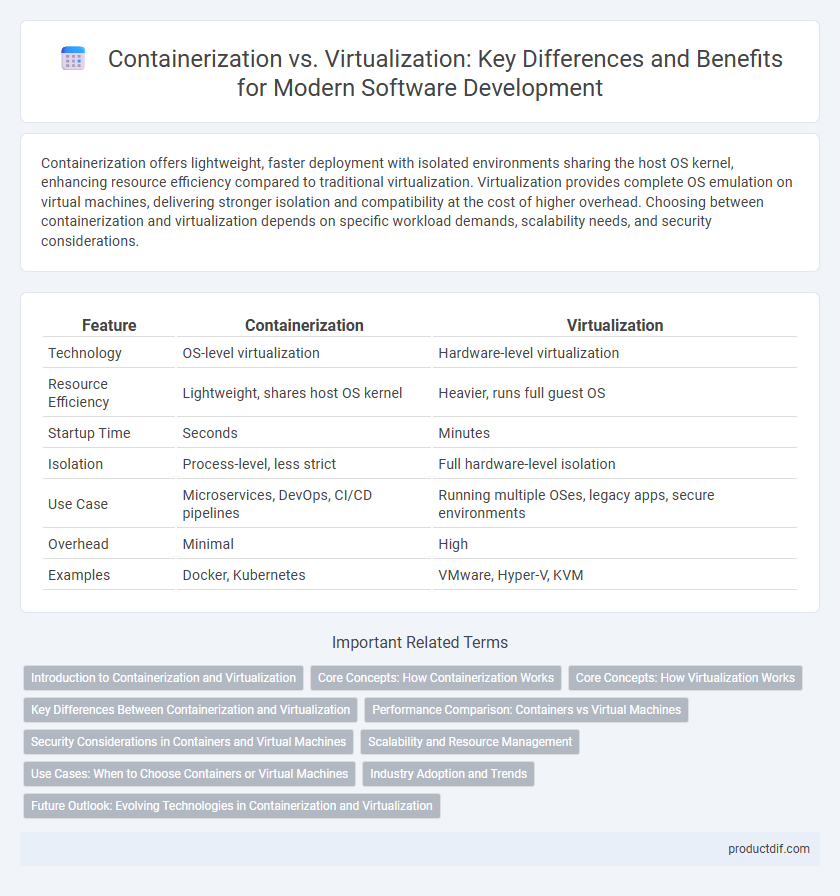Containerization offers lightweight, faster deployment with isolated environments sharing the host OS kernel, enhancing resource efficiency compared to traditional virtualization. Virtualization provides complete OS emulation on virtual machines, delivering stronger isolation and compatibility at the cost of higher overhead. Choosing between containerization and virtualization depends on specific workload demands, scalability needs, and security considerations.
Table of Comparison
| Feature | Containerization | Virtualization |
|---|---|---|
| Technology | OS-level virtualization | Hardware-level virtualization |
| Resource Efficiency | Lightweight, shares host OS kernel | Heavier, runs full guest OS |
| Startup Time | Seconds | Minutes |
| Isolation | Process-level, less strict | Full hardware-level isolation |
| Use Case | Microservices, DevOps, CI/CD pipelines | Running multiple OSes, legacy apps, secure environments |
| Overhead | Minimal | High |
| Examples | Docker, Kubernetes | VMware, Hyper-V, KVM |
Introduction to Containerization and Virtualization
Containerization uses lightweight, isolated environments called containers that share the host OS kernel while running applications, enabling faster deployment and reduced overhead. Virtualization involves creating full-fledged virtual machines (VMs) with separate guest operating systems on top of a hypervisor, offering strong isolation but increased resource consumption. Containerization excels in microservices and DevOps workflows, whereas virtualization remains ideal for running multiple OS types and legacy applications.
Core Concepts: How Containerization Works
Containerization works by encapsulating an application and its dependencies into a lightweight, standalone container that runs consistently across different computing environments. Unlike virtualization, which requires a full guest operating system, containers share the host OS kernel while isolating the application processes, enabling faster startup times and efficient resource utilization. This approach leverages namespaces and control groups (cgroups) in the Linux kernel to provide isolation and limit resource consumption for each container.
Core Concepts: How Virtualization Works
Virtualization creates multiple simulated environments from a single physical hardware system by using a hypervisor to abstract and allocate resources such as CPU, memory, and storage to virtual machines. Each virtual machine operates with its own guest operating system, enabling isolation and efficient utilization of hardware. This core technology allows multiple OS instances to coexist independently on one physical server, enhancing flexibility and scalability.
Key Differences Between Containerization and Virtualization
Containerization enables lightweight, isolated application environments by sharing the host OS kernel, while virtualization involves running multiple full guest operating systems on a hypervisor. Containers offer faster startup times and higher resource efficiency compared to virtual machines, which require more system resources due to full OS replication. Security models also differ, with containers relying on OS-level isolation and virtual machines providing stronger hardware-level segregation.
Performance Comparison: Containers vs Virtual Machines
Containerization delivers superior performance compared to virtual machines by leveraging lightweight OS-level virtualization, which minimizes resource overhead and enables faster startup times. Virtual machines require full guest operating systems, resulting in greater CPU and memory consumption that can degrade application performance under heavy workloads. Benchmark tests consistently show containers achieving near-native speeds, making them ideal for scalable and resource-efficient deployment of microservices.
Security Considerations in Containers and Virtual Machines
Containerization isolates applications by sharing the host OS kernel, which reduces overhead but may expose vulnerabilities through kernel exploits if improperly configured. Virtual machines provide stronger security boundaries by running full guest OS instances, offering hardware-level isolation that limits the impact of compromised workloads. Proper security measures like namespace isolation, mandatory access controls, and hypervisor hardening are critical to mitigate risks in both container and VM environments.
Scalability and Resource Management
Containerization offers superior scalability by enabling rapid deployment of lightweight, isolated application instances that share the host OS kernel, resulting in efficient resource utilization. Virtualization, while providing strong isolation through full guest OS instances, incurs higher overhead due to multiple OS copies, which can limit scalability and increase resource consumption. Effective resource management in containerization leverages dynamic orchestration tools like Kubernetes to optimize compute allocation, whereas virtualization relies on hypervisor-level controls that may be less flexible in large-scale environments.
Use Cases: When to Choose Containers or Virtual Machines
Containers are ideal for microservices architectures, continuous integration/continuous deployment (CI/CD) pipelines, and applications requiring rapid scaling due to their lightweight nature and fast startup times. Virtual machines (VMs) offer better isolation and are preferred for running multiple different operating systems on the same hardware or legacy applications that demand strong security and resource allocation. Enterprises should evaluate workload requirements, security needs, and infrastructure compatibility to decide between containers, which optimize resource efficiency, and VMs, which provide comprehensive hardware virtualization.
Industry Adoption and Trends
Containerization has gained widespread industry adoption due to its lightweight efficiency and faster deployment compared to traditional virtualization, attracting major enterprises like Google, Amazon, and Microsoft. Virtualization remains critical for legacy application support and environments requiring strong isolation, particularly in sectors such as finance and healthcare. Current trends show a hybrid approach emerging, combining container orchestration platforms like Kubernetes with virtual machine infrastructure to optimize scalability and security.
Future Outlook: Evolving Technologies in Containerization and Virtualization
Advancements in containerization are driving lightweight, scalable application deployment with technologies like Kubernetes and Docker leading orchestration innovations. Virtualization continues evolving through improved hypervisor efficiency and integration with cloud-native services, enhancing resource allocation for diverse workloads. The convergence of container and virtualization technologies is expected to enable hybrid environments, fostering seamless application portability and optimized infrastructure utilization.
Containerization vs Virtualization Infographic

 productdif.com
productdif.com